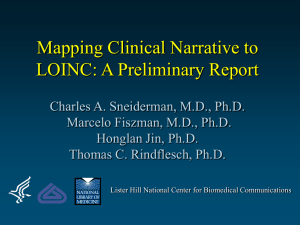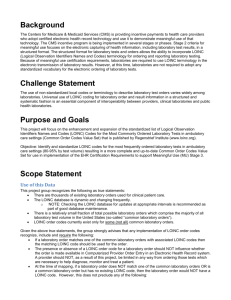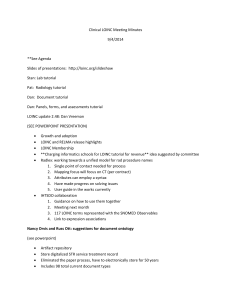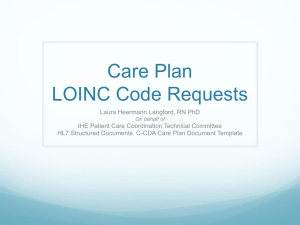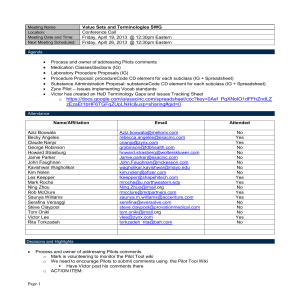aLOINC Order Code S&I Initiative
advertisement
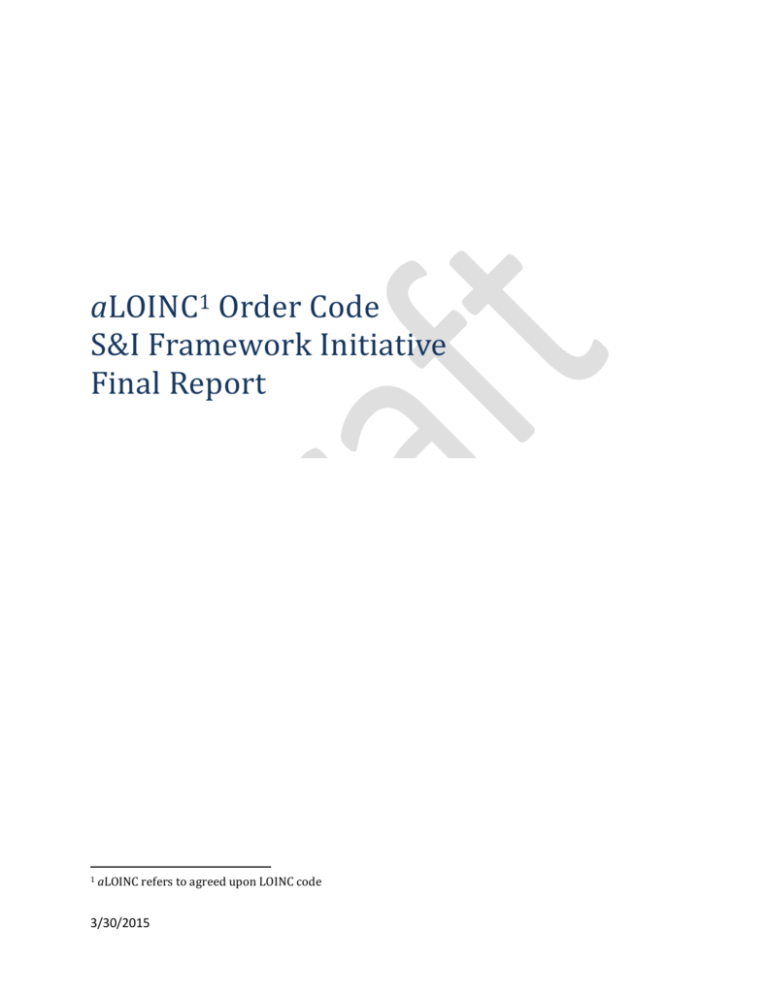
aLOINC1 Order Code S&I Framework Initiative Final Report 1 aLOINC refers to agreed upon LOINC code 3/30/2015 Table of Contents Table of Contents ................................................................................................................................................................ 2 Chairs:...................................................................................................................................................................................... 3 Members: ............................................................................................................................................................................... 3 Executive Summary ................................................................................................................................................................ 4 Background ................................................................................................................................................................................ 6 Activities/Approach ............................................................................................................................................................... 8 S and I Framework Initiative – aLOINC Order Code............................................................................................. 8 Analysis of Data ................................................................................................................................................................... 8 aLOINC Common Order Codes Value Set .............................................. Error! Bookmark not defined. Report of Indiana Network for Patient Care (INPC) Data Building a Common LOINC Laboratory Order Set............................................................................................................................................................................ 9 MarketScan data ........................................................................................................................................................... 10 Review of Reference Laboratory Test Orders .................................................................................................. 11 Conclusion of Data Analysis .............................................................................................................................................. 11 Lesson Learned....................................................................................................................................................................... 13 Volume Data Comparisons............................................................................................................................................ 13 Difference in Order Codes and Resulted Test Codes .......................................................................................... 14 Use of Local Codes ............................................................................................................................................................ 15 Use of this Data .................................................................................................................................................................. 15 Need for training products ........................................................................................................................................... 16 Coordination with Public Health Tiger Team ....................................................................................................... 16 Appendix A – Scope Document ........................................................................................................................................ 17 Appendix B – Recommendations for Regenstrief .................................................................................................... 18 Appendix C – aLOINC Common Order Code Value Set........................................................................................... 19 Appendix D – Indiana Network for Patient Care (INPC) Summary Analysis ................................................ 20 Appendix D – Business Rules for Comparing a User-defined Panel to a LOINC Panel.............................. 21 Appendix F – Canadian Test Order List ........................................................................................................................ 22 References ................................................................................................................................................................................ 23 2|Page Chairs: MariBeth Gagnon - Centers for Disease Control and Prevention Nancy Cornish - Centers for Disease Control and Prevention Anne Pollock - Centers for Disease Control and Prevention Members: Travis Adams- Humana Inc. Todd Alspach – Centers for Medicare & Medicaid Services Patricia Anderson – Mayo Clinic Laboratories Pam Banning - 3M Health Information Systems Valerie Britt – Leidos Health Jane Burke - Halfpenny Technologies, Inc. Lorie Carey - Canada Health Infoway Alexis Carter – Emory Healthcare James Case – National Library of Medicine Colleen Diaz Robert Dieterle - Office of the National Coordinator Gai Elhanan - Halfpenny Technologies, Inc. John Feikema - Office of the National Coordinator Roy Gill - NextGen HealthCare Rebecca Goodwin – National Library of Medicine Cynthia Johns - Laboratory Corporation of America Terri Johnson – Zynx Health, Inc. Sandy Jones - Centers for Disease Control and Prevention Steve Groskreutz - Mayo Clinic Laboratories Eric Haas - Association of Public Health Laboratories Katy Holck - Regenstrief Institute Julie Luepke - Mayo Clinic Laboratories Clem McDonald – National Library of Medicine Mary Kennedy - College of American Pathologists Carolyn Knapik – College of American Pathologists Susan Korsak - Partners Healthcare Eleonor Lijoi – Quest Diagnostics Graylin Mitchell - Centers for Disease Control and Prevention Andrea Pitkus – Intelligent Medical Objects Tawni Reller – Tawni Reller Consulting Jerry Sable – Association of Public Health Laboratories Stephen Soroka – Centers for Disease Control and Prevention Sonya Strider - Centers for Disease Control and Prevention Virginia Sturmfels - Quest Diagnostics Ron Van Duyne – Centers for Disease Control and Prevention Daniel Vreeman - Regenstrief Institute Kathy Walsh - Laboratory Corporation of America Bob Yencha- Office of the National Coordinator 3|Page Executive Summary The S&I framework initiative aLOINC Order Codes launched January, 2014. The charge was to provide a common order code value set for the Laboratory Orders Interface and Electronic Directory of Services Implementation guides. The group addressed issues where LOINC® (Logical Observation Identifiers Names and Codes) mapping was problematic for laboratories. The key deliverables of this group include: 1) aLOINC Common Order Codes Value Set, 2) input to Regenstrief on guidance for comparing user panels to LOINC panels, 3) Recommendations to the Office of the National Coordinator (ONC) on how to use LOINC for laboratory orders, and 4) Recommended content updates for Regenstrief based on review of laboratory order LOINC codes. The group would like to offer the following recommendations to ONC on how to use LOINC codes for laboratory orders: 1) The purpose of the aLOINC Common Order Codes Value Set is for identifying the most commonly ordered tests. 2) Best practices in LOINC mapping (map to what matches, request a new code when needed) should be applied to the aLOINC Common Order Codes Value Set. If a laboratory test does not match a corresponding test on the aLOINC Common Order Codes Value Set, the larger LOINC database should be searched for a more applicable LOINC term. If an appropriate LOINC code cannot be found for the test offered, a new LOINC code should be requested from Regenstrief using the process described at http://loinc.org/submissions/new-terms 3) A major barrier to the development of an empiric list of common laboratory order (or result) codes is the lack of nationally representative data. To ensure that such a list can be updated efficiently, ONC should help facilitate a collection of national laboratory order and result volume coded with LOINC. 4) Recommended guidelines developed by this group for comparing a user-defined panel to an existing LOINC panel are an attempt to provide flexibility and allow laboratories a mechanism for comparing their laboratory panel to a LOINC panel to determine equivalency. ONC, Regenstrief and NLM need to work with the laboratory community to address the need for more flexibility. 5) We support the use of LOINC as the universal code for laboratory orders. We recognized best practice in messaging is to exchange both the local and the standard code. Further, we recognize that there will be some cases where an appropriate LOINC code does not exist for the test (such as a brand new test). ONC will need to keep this fact in mind on future efforts to standardize coding. 6) ONC should encourage the development of training aids utilizing the LOINC database supporting fields to help laboratories understand how to select LOINC codes for mapping. 7) ONC should promote collaboration between FDA and the Regenstrief Institute to develop a process where an instrument and/or reagent manufacturer would assign an appropriate 4|Page existing LOINC code or submit a request for a LOINC code from Regenstrief during the approval process (i.e. Provided in the Manufacturer’s package insert or other mechanism that allows easy access to the codes in one location). The provision of manufacturerspecified LOINC codes would help standardize laboratory test mapping. 8) ONC should develop a process for standardization of laboratory test reporting that provides coordination between clinical laboratory efforts and public health test results. 9) ONC should ensure that the Regenstrief Institute has sufficient resources to provide a timely response to the anticipated increased demand for new LOINC codes. 10) A model needs to be developed for coding anatomic pathology and cytology tests, where a test may include several codes (specimen collection, processing, and interpretation) for orders and results. We recognize the test is for one analyte, therefore it is not a panel. However, if several codes are needed, there may need to be a way to link all the codes for one test together. ONC and the Regenstrief Institute will need to consider how multiple codes for one analyte are recorded in a structured format which typically has one code per analyte. 5|Page Background Electronic health record (EHR) usage has increased in the last five years1,2 partly due to the Centers for Medicare & Medicaid Services (CMS) providing incentive payments to health care providers who adopt certified electronic health record technology and use it to demonstrate meaningful use of that technology. The CMS incentive program (often identified as Meaningful Use) Stage 2 criteria focuses on the capacity to electronically capture health information, specifically germane for this project is laboratory test orders and results. More than 30% of laboratory test orders must be generated using computerized order entry (CPOE) and more than 55% of all clinical laboratory test results reported as a numeric or positive/negative values must be incorporated in a certified electronic health record (CEHRT) as structured data3. The federal government has invested about $29 billion (as of the end of 2014)4 in incentive payments that reimburse healthcare providers if they install an electronic health record system. Logical Observation Identifiers Names and Codes (LOINC) is a system of coding medical observations and events developed by the Regenstrief Institute is the required vocabulary for reporting laboratory test results and is the proposed vocabulary standard for orders. Due to the publication of these meaningful use requirements and the need for healthcare providers and hospitals to qualify for the incentive payments, laboratories will be expected to provide laboratory orders and laboratory results that include LOINC codes and vendors will be expected to provide the capability for LOINC’s usage. The College of American Pathologists (CAP) Diagnostic Intelligence & Health Information Technology (DIHIT) Committee identified this lack of standardization of test definitions, names and codes in a published White Pater on Laboratory Interoperability Best Practices5. DIHIT listed Mistake #3: Not uniquely identifying test names using LOINC and suggested “every laboratory would need a LOINCologist to oversee the development and deployment of LOINC in the LIS and interfaced systems.” Lack of a standardized vocabulary is a barrier to interoperability. Without standardization data received from one electronic health information system to another is not fully computable when it accessed or received. The receiver’s system cannot entirely process, parse and/or present data for the user in meaningful ways. EHR vendors cannot efficiently pre-populate order menus for clinicians or trend data over time unless there is standardization of the codes. It would be impossible to support clinical decision rules, surveillance activities, and analyze quality measures of performance. If mapped incorrectly there is no guarantee the values are interpreted correctly. Incorrect mapping may result in patient harm due to loss of information or results being mapped to the incorrect tests in the display. Laboratories often lack personnel with domain expertise in vocabulary standards that can be dedicated to support the health information system. The CMS incentive rule and the ONC certification rule have increased the awareness of the need for standardized vocabulary to connect with other healthcare systems. One outcome of this awareness is an increase of US LOINC users. Mapping to LOINC can be a complex and resource intensive process.6,7,8,9,10 Even with the best available automated tools, mapping to a standardized terminology often requires extensive human 6|Page review by domain experts. To that end, the Regenstrief Institute and the National Library of Medicine (NLM) have developed a nationally-representative set of the Top 2000+LOINC®result codes and produced a companion LOINC Mapper’s Guide to the Top 2000+ US Lab Tests (both available at http://LOINC.org/usage/obs ) with guidance to implementers about mapping local codes to LOINC. NLM and the Regenstrief Institute collaborated with several organizations to develop an empirically based list of the most commonly ordered tests. The outcome of that process was the LOINC® Top 300 Universal Orders list (http://LOINC.org/usage/orders), a collection of codes accounting for more than 98% of the volume for five large, nationally-representative data sources. 7|Page Activities/Approach S and I Framework Initiative – aLOINC Order Code The Office of the National Coordinator for Health Information Technology (ONC) Standards and Interoperability (S&I) Framework is a collaborative community of participants from the public and private sectors who are focused on providing the tools, services and guidance to facilitate the functional exchange of health information. The S&I Framework has several initiatives related to laboratory interoperability including the Laboratory Orders Interface (LOI), the Laboratory Results Interface (LRI), electronic Directory of Services (eDOS), and Electronic Health Record System Functional Requirements (EHR-S-FR). Implementation guides for laboratory test orders11 and results12 interfaces are two of the products produced by this collaboration. During the collaborative process for developing the Implementation Guides, there was a discussion how LOINC order and result codes shall be carried in the message. It was determined that laboratories should use the LOINC code, when available. However, local codes may also be carried in the message when LOINC is not available or in addition to LOINC. The group also discussed the need to expand the list of Universal Order Codes from LOINC. A planning group was convened to develop a new S&I Framework initiative called aLOINC Order Code. The meeting announcement was published December 10, 2013 and the initiative launched January 8, 2014. Purpose: The use of non-standardized local codes or terminology to describe laboratory test orders varies widely among laboratories. Universal use of LOINC coding for laboratory order and result information in a structured and systematic fashion is an essential component of interoperability between providers, clinical laboratories and public health laboratories. This project will focus on the enhancement and expansion of Logical Observation Identifiers Names and Codes (LOINC) for commonly ordered clinical laboratory tests in the ambulatory care settings and for tests ordered in the public health settings. This goal is for the Regenstrief Institute to publish up-to-date lists of clinical and public health Order Codes Value Sets that could be recommended for incorporation in EHR Meaningful Use (MU) stage 3 and to support certification requirements. The scope document is in Appendix A. Analysis of Data aLOINC Common Order Codes Value Set Two national reference laboratories provided a comparison of the top 500 tests performed at their facilities to a combined list of Regenstrief’s Top 300 Universal Order Codes and Top 2000 Results Codes. Codes thought to not be ordered in an ambulatory care setting and duplicate codes were removed from the list. Tests (with corresponding LOINC codes) were categorized into three different classifications; Order, Observation or Both. All “deprecated” and “discouraged” LOINC codes were replaced with active LOINC codes from the RELMA database. The tests were divided 8|Page into two spreadsheets, one for single stand-alone orderable tests and one for panels. The two spreadsheets make up the aLOINC Common Order Codes Value Set. Participants on the weekly aLOINC Order Code Initiative conference calls were asked to compare the aLOINC Common Order Codes Value Set to the list of orderable test in the laboratory where they worked. They were also asked to identify tests not on the list that should be included or tests that were on the list and should not be (either because they are not done in an ambulatory setting or if on the single test spreadsheet, because they are not offered as a stand-alone orderable test). All lists sent in by the members were combined and compared to the aLOINC Common Order Codes Value Set, and any “new” single tests and panels were added. The vetting of the list continued weekly during each call, with each test and panel brought up for a detailed discussion. Any comments pertaining to the validity of tests and panels were noted and discussed. Comments or concerns included but were not limited to the following: designation of observation only and tests discouraged by Regenstrief. We developed a list of recommendations for NLM and Regenstrief to consider. The List of Recommended content updates for the Regenstrief Institute based on review of laboratory order LOINC codes is in Appendix B. The final resulting spreadsheet has a total of 1532 orderable tests contained under two tabs: single tests (1378) and panels (156). This spreadsheet would be considered the initial aLOINC Common Order Codes Value Set. The aLOINC Common Order Codes Value Set is in Appendix C. Report of the Indiana Network of Patient Care (INPC) Data and LOINC® Top 300 Orders List The California HealthCare Foundation provided funds to Regenstrief Institute, Inc. to collect data from 10 different institutions in the INPC for the period of January 2011 to at least January 2013 to help with developing a list of the most commonly ordered laboratory tests. The data fields extracted include: laboratory order code, order name, result code, result name, LOINC, units of measure, and any metadata (such as service location) indicating that an order was placed in an ambulatory care setting. Laboratory data was extracted for the period January 1, 2011 through January 1, 2013. The list of order codes was reviewed and an attempt was made to identify those that represented panels and those that represented single tests. In so doing a small number of local panel codes (less than 1% of the total volume) from various institutions had been mapped to Regenstrief Dictionary codes that represented classes of tests rather than true panels. For example, the term “Cholesterol Tests and Lipid Panels” is meant to be used for grouping a domain of tests rather than representing a specific panel. Such terms were excluded from the final set. A summary of the analysis is in Appendix D. The data extracted from INPC represented 173,929,006 laboratory orders. The local tests from these 10 institutions were mapped to 3,538 Regenstrief Dictionary codes, of which 2710 were mapped to LOINC codes. 396 of the 3,538 Regenstrief Dictionary codes were mapped to LOINC codes contained in the LOINC Top 300 list. Of the 313 LOINC codes in the LOINC Top 300 Universal Orders list, 242 were mapped to Regenstrief Dictionary terms in our data set. The list of order 9|Page codes was condensed by aggregating the volume of any code mapped to the same LOINC code, producing 3,127 order codes. The table below shows the number of unique laboratory codes accounting for specific levels of the overall volume, as a corollary, while 635 Regenstrief Dictionary codes accounted for 99.5% of the volume, the remaining 2,903 codes accounted for remaining 0.5%. This means, there is a very long list of tests with little volume. (Table 1) Table 1: Number of codes accounting for the top 90-99.5% of overall order volume Accounting for 90% of volume Accounting for 95% of volume Accounting for 99% of volume Accounting for 99.5% of volume Unique Regenstrief Dictionary Codes* LOINC® codes with aggregated volume and remaining unmapped Regenstrief Dictionary Codes* 50 117 435 635 37 93 356 527 *numbers are accumulative with increasing volume MarketScan data CDC staff analyzed data from the 2012 Truven Health MarketScan® Laboratory Database. This laboratory database contains commercial payer and Medicare clinical laboratory results linked at the de-identified patient level to the same patient’s healthcare claims. The laboratory tests are ordered in office-based practices and sent to a central reference laboratory. Central reference laboratories serve office-based medical practices where testing volume is not sufficient to support investment in a full-scale laboratory infrastructure. Blood, urine, and tissue samples are obtained at medical offices and shipped to a central laboratory for analysis. Since most tests are run on automated equipment with digital output, test results are entered routinely into electronic databases. Thus, the data is representative of pooled laboratory data from reference laboratories and includes laboratory tests performed in an ambulatory setting that produce a computer generated result. The data does not include laboratory tests performed in hospitals or in doctors’ offices. The database includes 6.9 million unique patient enrollees for the last 5 years or approximately 17% of the enrollee who have at least one laboratory test result in addition to other claims data. (Table 2) Table 2: MarketScan Enrollee type Commercial Payer Enrollees Medicare Enrollees Total Enrollees (Commercial Payer + Medicare) Enrollees with at least 1 laboratory test Number (percent) 109,469,096 8,644,677 118,113,773 6,932,832 (17%) 10 | P a g e The data contains 73,402,305 laboratory tests that are represented by 7,362 unique LOINC® codes. The table below shows the number of unique laboratory codes accounting for specific levels of the overall volume in one year of data (2012). Table 3: Number of codes accounting for the top 90-99.5% of overall order volume % of volume Accounting for 90% of volume Accounting for 95% of volume Accounting for 99% of volume Accounting for 99.5% of volume Unique LOINC® Codes* 327 647 1595 2115 *numbers are accumulative with increasing volume Review of Reference Laboratory Test Orders A review of the laboratory LOINC order codes obtained from four large reference laboratories showed variation in selection of the LOINC® code and name used by the laboratory. A comparison of these test lists to the aLOINC Common Order Codes Value Set demonstrated a close matching of codes with one of the laboratories, but for two of the laboratories few to none of the codes matched codes on the aLOINC Common Order Codes Value Set. This may be due to the laboratory performing the test using a different method or reported with different units of measure. In other words the variation appeared to be due to variation in laboratory practice. During this review we found a consistency with the laboratories’ choice of local test name. Each laboratory has business rules for applying the test names, but the business rules lack consistency throughout the US. 11 | P a g e Conclusion of Data Analysis This group was asked to provide a value set of LOINC order codes for the most commonly ordered laboratory tests in an ambulatory setting, defined as an order for a laboratory test which is highly likely to be included in the top 95% of a laboratory’s orders by volume. However, these orders represent a relatively small proportion of the total laboratory tests that a laboratory may provide. For example, one member of the group reported that her laboratory provides a total of 1134 different laboratory tests (including individual analytes and panels), orders for only 211 of these tests comprised 95% of the laboratory volume. Orders for the remaining 923 tests together comprised less than 5% of all laboratory orders. We found this to be true in the INPC data also. In the INPC data, 117 tests represented the top 95% of the 173,929,006 laboratory orders. None of the data sets we were able to obtain were representative of a national sample of laboratory test orders. Therefore, it is not possible to make a meaningful comparison of the data sets. The aLOINC Common Order Codes Value Set is not based on volume information. INPC and MarketScan data were for different lengths of time. The INPC data is representative of laboratory orders, while the aLOINC Common Order Codes Value Set and MarketScan list are based on resulted test codes. If you look at only trying to match the LOINC code from one set to the other, a code that has high ranking in one or two sets may not be included in the third set. For instance, Creatinine in Serum/Plasma LOINC code 2160-0 was the most requested test in the MarketScan data and ranked within the highest panel requested by INPC, but the code was not found in the aLOINC Common Order Codes Value Set. On the other hand, the aLOINC Common Order Codes Value Set contained Creatinine in Blood LOINC code 38483-4, which was found in both of the other lists. We conclude that while volume data for a small laboratory would have a small number of tests making up the top 95% of their volume, the tests in one laboratory will not be the same due to variation in laboratory practices. A national sample would produce a much larger list. 12 | P a g e Lesson Learned The group identified several challenges and opportunities that support our recommendations. In this section we have grouped our comments under five headers: Volume Data Comparisons; Differences in Order and Result Codes; Need for Local Codes; Need for Training Products and Coordination with Public Health Tiger Team. Volume Data Comparisons Obtaining a national sample of laboratory order data that is collected by a standardized approach, such as that used by INPC, would be beneficial. ONC may wish to consider finding a way to obtain laboratory order volume data, such as requiring institutions to include data in the attestation statement provided to CMS under the incentive rule. The aLOINC Common Order Codes Value Set we are providing may not be representative of a national sample. A list of common orders for single analytes based on using the same code for both orders and results may end up being quite a bit larger than this list due to the variability of test methods used across laboratories in the United States. If a national sample were obtained, trends may be identified such as a list of codes that will be used by smaller laboratories, another list that will be used by larger laboratories or another in laboratories that do primarily specialty testing. The list of common orders for panels may not include as much variation between laboratories since some are defined by CMS. The panels are represented by one order code and several normally resulted test codes or possible resulted test codes. The group recognized that with more users mapping and requesting LOINC codes, this homogeneity may get lost when laboratories try to make an existing panel code match a panel used by that laboratory. This can result in the request for duplicate codes for the same test. The Regenstrief Institute and NLM may need to work with the laboratory community to address needs for order panels that may be missing or which do not include all of the result elements that a particular laboratory may include in its panel. The group asked for more flexibility in matching the laboratory’s panel to an identified LOINC panel. The outcome was the development of a guidance document containing business rules to apply when comparing a laboratory’s panel to a panel already identified in LOINC. NLM and the Regenstrief Institute plans to incorporate these rules in the LOINC® User’s Guide. The Business Rules for Comparing a User-Defined Panel to a LOINC panel code are in Appendix E. Since our aLOINC Common Order Codes Value Set may not be representative of the methods employed by the laboratory that may use it for mapping purposes, we suggest this list be used only as a first review. If a LOINC order code matching the laboratory’s test cannot be found, then: the larger LOINC database can be searched for a more applicable LOINC code, a new code may be requested from Regenstrief. Another problem identified by the group was in the reporting of anatomic pathology. In anatomic pathology, there are several resulted codes representing multiple specimens or multiple analysis types attached to a single test order. One approach discussed by the group was to consider these tests as a panel. However, NLM pointed out that anatomic pathology tests do not meet the requirements to be designated as a panel, since it is not a test for multiple analytes. LOINC was 13 | P a g e designed to handle a single result per test with a single code and was not designed for the degree of variability or complexity in an Anatomic Pathology report. As such, orders for Anatomic Pathology tests are not easily amenable to existing LOINC order codes. A model may need to be developed for coding anatomic pathology and cytology tests, where a test may include several codes (specimen collection, processing, and interpretation) for orders and results. If several codes are needed, there may need to be a way to link all the codes for one test together Difference in Order Codes and Resulted Test Codes LOINC provides a set of universal names and ID codes for identifying laboratory and clinical observations13. It is a non-hierarchical coding system in which the coded representation for a particular test result. The primary purpose of LOINC promotes interoperability by standardizing codes for equivalent laboratory and clinical test results between systems. For resulted tests, equivalency is determined by ensuring that multiple components of the laboratory test are similar (e.g., method, units of measure, timing before or after an event). LOINC was not natively designed to handle laboratory or clinical test orders which are specific to an analyte but usually not to method or units of measure. When the same LOINC is used to refer to the resulted test code or to the order for the same analyte or panel of analytes, there is no visual differentiation of the code when identified in the EHR. Once the LOINC code is parsed out of the HL7 message and stored in an EHR or other database, it may not be possible to determine if the code was originally attached to an order or a result unless the metadata is preserved. Differentiation of orders from results is quite valuable when data mining for quality assurance, research and for public health, especially if one is trying to monitor for and respond early to infectious disease outbreaks, bio- or chemical terrorism, etc. If the metadata is not preserved, a prefix, suffix or other indicator could be added to a LOINC order code to identify it as such. Result codes should be left as they are. A standard prefix or suffix for order codes could easily be added to the list of order codes One idea that was discussed was to use methodless codes, as is the practice in Canada. The PanCanadian LOINC Observation Code Database (pCLOCD)14 Nomenclature Standard allows access, management and storage of patient laboratory orders and resulted tests across the continuum of care through a jurisdictional Laboratory Information System. It is based on the international LOINC® standard. The Canadians recognized the need to standardize the coding and naming of laboratory test to prevent duplication when a patient visits different health care providers. Making test information widely available online ensures the timely access to laboratory test information that can impact clinical decision making. Canada Health Infoway provided a list of methodless codes for consideration by the group, Appendix F. Currently the ordering provider selects the test to be ordered by name, not a code. Laboratories have adopted local names which are also not standardized. This makes computerized provider order entry difficult when faced with a single EHR-S interface. Inclusion of laboratory test specific 14 | P a g e information, such as method or unit of measure may further increase the difficulty of the provider selecting the right test for a particular analyte. Choosing the wrong test may result in delay of treatment and sometimes may result in patient harm. For some analytes (e.g., Human Immunodeficiency Virus or HIV), the ordering provider needs to know the method because one is used as a screening test (e.g., HIV ELISA), one is used as a confirmatory test only when the screening test is positive (e.g., HIV by Western blot) and another is used to monitor viral loads (e.g., HIV by reverse transcriptase PCR). There will have to be a balance of allowing the provider to request a test using the test name they are familiar with and mapping of test names to a standardized list of codes. If the provider is suddenly faced with new test names it may result in ordering the wrong test, not understanding the results reported back or delay of receiving the results needed to diagnose the patient’s condition. All of these issues raise concern for patient safety and risk of harm. Use of Local Codes The group was very concerned about the purpose of the initiative in developing a standardized set of common LOINC order codes and how the list would be used. The group did not want this list to be construed as a constrained value set. They decided to add a section to our scope statement that would address this concern. The following was added to the initiative’s scope document on January 14, 2015: Use of this Data This project group recognizes the following as true statements: There are thousands of existing laboratory orderable tests used for clinical patient care. The LOINC database is dynamic and changing frequently. o NOTE: Checking the LOINC database for updates at appropriate intervals is recommended as part of good database maintenance. There is a relatively small fraction of total possible laboratory orders which comprise the majority of all laboratory test volume in the United States (so-called “common laboratory orders”). LOINC order codes currently exist for some, but not all, of the common laboratory orders. Given the above true statements, the group strongly advises that any implementation of LOINC order codes recognize the following: If a laboratory order matches one of the common laboratory orders with associated LOINC codes then the matching LOINC code should be used for the order. The absence of a LOINC order code should not prevent the use of a local code for ordering laboratory testing However, this does not preclude any of the following: o Use of a LOINC order code for a non-common laboratory order. o Processing a laboratory order that does not contain an associated LOINC code. o Applying for a new LOINC order code. 15 | P a g e o Re-checking the LOINC order code database at a later date and updating the order with a subsequently available and appropriate LOINC order code. Need for Training Products Mapping of laboratory resulted tests to LOINC codes (an activity which has been in place longer than for orders) is not well understood and prone to error when performed by most individuals unless they are specially trained in terminology practices, particularly LOINC mapping. Conversely, mapping of LOINC codes to laboratory orders or resulted tests without an in-depth knowledge of the laboratory’s test menu is similarly prone to error. Most laboratories do not have the financial resources to hire specialists in LOINC coding. Training aids may need to be developed to help mappers or provide incentives for laboratories to train and/or hire individuals who will be able to accurately assign LOINC codes to orders and resulted tests. Collaboration between FDA and the Regenstrief Institute to develop a process where the manufacturer of an instrument and/or test reagent obtains LOINC codes from Regenstrief during the FDA approval process (i.e., included in the manufacturer’s package insert or other means that provides coding access at one site). LOINC codes provided by manufacturers will help standardize laboratory test mapping, making it easier to assign the right code. Coordination with Public Health Tiger Team The Public Health Tiger Team is developing a standardized approach for collection of result tests for reportable conditions and cancer reporting. They are coordinating three initiatives that will promote and strengthen public health by leveraging technologies and standards. The three focal initiatives that will be coordinated within by the tiger team are: Structured Data Capture (SDC), Data Access Framework (DAF) and Health eDecisons (HeD). The efforts of this group must be coordinated with clinical laboratory reporting. The efforts of clinical laboratories and public health should result in a selection of the same codes for the same analyte or test. 16 | P a g e Appendix A – Scope Document aLOINC Scope Statement.pdf 17 | P a g e Appendix B – Recommended Content Updates for Regenstrief Based on Review of Laboratory Order LOINC Codes List of Recommended Content Updates for the Regenstrief Institute.docx 18 | P a g e Appendix C – aLOINC Common Order Codes Value Set LOINC Order Codes Baseline List - Final.xls 19 | P a g e Appendix D – INPC Summary Analysis 2014 01 31 - Interim Deliverable - INPC Key Statistical Summary - forDistribution.pdf 20 | P a g e Appendix D – Business Rules for Comparing a User-defined Panel to a LOINC Panel Business rules.pdf 21 | P a g e Appendix F – Canadian Test Order List Canada Physician Order Codes.xlsx 22 | P a g e References Charles D, Gabriel M, and Furukawa MF. Adoption of Electronic Health Record Systems among U.S. Non-federal Acute Care Hospitals: 2008-2013; ONC Data Brief ■ No. 16 ■ May 2014 http://www.healthit.gov/sites/default/files/oncdatabrief16.pdf 2 HHS Press release More physicians and hospitals are using EHRs than before. August 7, 2014 http://www.hhs.gov/news/press/2014pres/08/20140807a.html 3 42 CFR Parts 412, 413, and 495 Medicare and Medicaid Programs; Electronic Health Record Incentive Program—Stage 2. Federal Register 77, No. 171 / Tuesday, September 4, 2012, pp 53967 – 54162. http://www.gpo.gov/fdsys/pkg/FR-2012-09-04/pdf/2012-21050.pdf 4 CMS EHR Incentive Program Summary http://www.cms.gov/EHRIncentivePrograms 5 Beckwith BA, Aller RD, Brassel JH, Brodsky VB and de Bacca ME. Laboratory Interoperability Best Practices: Ten Mistakes to Avoid. March 2013, http://www.cap.org/apps/docs/committees/informatics/cap_dihit_lab_interop_final_march_2013. pdf 6 Baorto DM, Cimino JJ, Parvin CA, Kahn MG. Combining laboratory data sets from multiple institutions using the logical observation identifier names and codes (LOINC®). Int J Med Inf 1998;51:29-37. 7 Lin MC, Vreeman DJ, McDonald CJ, Huff SM. Correctness of Voluntary LOINC® Mapping for Laboratory Tests in Three Large Institutions.AMIA Annu Symp Proc 2010;2010:447-51. 8 Lin MC, Vreeman DJ, McDonald CJ, Huff SM. A characterization of local LOINC® mapping for laboratory tests in three large institutions. Methods Inf Med 2011;50:105-14. 9 Vreeman DJ, Stark M, Tomashefski GL, Phillips DR, Dexter PR. Embracing change in a health information exchange. AMIA Annu Symp Proc 2008:768-72. 10 Vreeman DJ, Finnell JT, Overhage JM. A rationale for parsimonious laboratory term mapping by frequency. AMIA Annu Symp Proc 2007:771-5. 11 HL7 Version 2.5.1 Implementation Guide: S&I Framework Laboratory Orders from EHR, Release 1 - US Realm 12 HL7 Version 2.5.1 Implementation Guide: S&I Framework Lab Results Interface, Release 1- US Realm 13 McDonald C, Huff S, Deckard J, Holck K, Abhyankar S, Vreeman DJ. Logical Observation Identifiers Names and Codes (LOINC). 2014; http://loinc.org/downloads/files/LOINCManual.pdf. Accessed February 18, 2015, 14 https://www.infoway-inforoute.ca/index.php/programs-services/standards-collaborative/pancanadian-standards/pan-canadian-loinc-observation-code-database-pclocd-nomenclaturestandard 1 23 | P a g e

